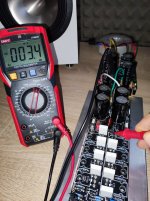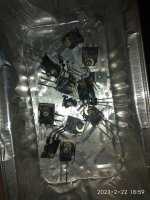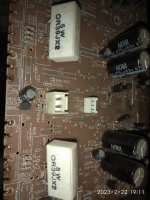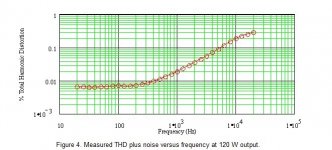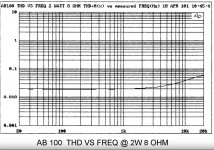Let us know your result with the Sanken transistors. NOT that easy to match darlingtos unfortunately.
I do not think it is necessary in this circuit. Yes it would help but not necessary.
I do not think it is necessary in this circuit. Yes it would help but not necessary.
Dear all, assuming a dc free source and dc detection plus power relay shutdown logic at the output, I am considering leaving the input capacitor entirely out (= shorting it). Everything else would follow the original circuit design. Is this a good / bad / very bad idea in terms of stability, sound, etc? Thanks, Miklos
It's bad practice in general.
But if your amplifier is always going to be connected to the same preamplifier and it has output capacitors, then you can omit the input capacitors in your amplifier.
But if your amplifier is always going to be connected to the same preamplifier and it has output capacitors, then you can omit the input capacitors in your amplifier.
Thank you, adiaz. Could you please explain in some more detail why is it a bad idea in general to omit the input capacitor? Only safety against dc, or is there more? (I do not have a good intuition how it would affect the actual NF loop, for instance) Looking at most other NP designs, there is no input cap. Specifically, I plan to build an integrated amp, consisting of a soekris dac + symmetrically biased, capacitor-less B1 with matched JFETs + AB100 + some safety logic including dc detection. I do not expect either the soekris dac or the B1 feeding any dc into the AB100 circuits. Or is this too naive? Thanks, Miklos
Yes, it is only for DC security exclusively.
In your case if the output of your electronics entering the amplifier is free of dc then there is no problem.
But from my own experience, I sometimes needed to test my amplifiers with other preamps (of friends, for example). And in that case it's not good, that's why I said it, no other reason.
In your case if the output of your electronics entering the amplifier is free of dc then there is no problem.
But from my own experience, I sometimes needed to test my amplifiers with other preamps (of friends, for example). And in that case it's not good, that's why I said it, no other reason.
Thank you, adiaz, for clarifying. I think I am going to prepare the PCB layout to host both input alternatives, just in case.
That option is the best. So if you ever need it you can put it on.
I always put them on, and I use Nichicon UES (bipolar muse) I really like them.
I have also put 100nF MKT in parallel with them, on some occasions
I always put them on, and I use Nichicon UES (bipolar muse) I really like them.
I have also put 100nF MKT in parallel with them, on some occasions
Thank you for the suggestion, I will certainly try the Nichicon as well.
To resume, for a short while I was wondering if having an input bandwidth higher (DC to some high frequency) than the one of the feedback loop (few Hz to some high frequency) could, in principle, mess up the output phase of the lowest frequency signals. But in the end I think that the input with the originally proposed 100uF cap has a cut-off frequency which is already way lower than anything I can ever squeeze out from my preamp. In that sense, leaving the input cap out or not shall not make any difference. On the other hand, the 1/f noise figure in the no-cap configuration can only be better, which may (again, in theory...) improve the sound. So I think I will just try all configurations including different caps.
To resume, for a short while I was wondering if having an input bandwidth higher (DC to some high frequency) than the one of the feedback loop (few Hz to some high frequency) could, in principle, mess up the output phase of the lowest frequency signals. But in the end I think that the input with the originally proposed 100uF cap has a cut-off frequency which is already way lower than anything I can ever squeeze out from my preamp. In that sense, leaving the input cap out or not shall not make any difference. On the other hand, the 1/f noise figure in the no-cap configuration can only be better, which may (again, in theory...) improve the sound. So I think I will just try all configurations including different caps.
Dear all, I have another question concerning the ground connections on NP's PCB layout: the GND side of R8 seems to share the GND lines of the decoupling capacitors C5 and C6 (although with minimal re-arrangements it could as well be connected to the input GND line). In contrast, D. Self says on page 600 in his power amp book: 'Rail decoupler capacitors must have a separate ground return to the Reservoir Ground. This ground must not share any part of the audio ground system'. So what are the arguments for one grounding solution vs the other? Where does this really matter at all? Thanks, Miklos
Last edited:
I couldn't stand it and had to do the first sound tests, ..
I've only listened to the mono, but my first impressions, but I expected more from the AB100. The bass is very decent, certainly the extreme filtration in the 67.000 uF + 225W toroid power supply has its share in it. The presentation of mids and highs doesn't sound as clean to me as on my Audiolab 6000A. But you certainly can't compare strereo vs mono...
I'll revive the second channel, throw it in the mudushop 3U box and then compare again.
I've only listened to the mono, but my first impressions, but I expected more from the AB100. The bass is very decent, certainly the extreme filtration in the 67.000 uF + 225W toroid power supply has its share in it. The presentation of mids and highs doesn't sound as clean to me as on my Audiolab 6000A. But you certainly can't compare strereo vs mono...
I'll revive the second channel, throw it in the mudushop 3U box and then compare again.
Slow and steady wins the race, perhaps adjusting the bias at different levels will give a sweet spot.
I see that you use screw terminal blocks at the input. Here is an absolutely banal trick to try in less than 5 minutes: solder-coat the bare and freshly cleaned wire ends and install them back in the screw terminals right away. If this improves the mids and highs, you might want to consider dropping the screw terminals at all, and solder the input lines to the board directly. (This once solved a similar problem for me in another setup. I have never used internal connectors in the signal and power lines ever since.)
From a salvaged THOMSON A.V receiver..Friends, my AB100 boards are almost ready, ...equipped with Nichicon (4x 6,800 uF) from the KG series. I'm only waiting for small capacitors ELNA (100uF) and ceramics from Charcroft Silver mica.
View attachment 1130774
I am going to use sanken 2SB1560/2SD2390 transistors. Have any of you used anything other than the TIP142/147?
At the moment I'm going to install parts for the SSR protection 🙂
View attachment 1130778
The whole amplifier will be designed as dual mono, 2x toroid, 2 power supply (4x 10.000 uF) in a 3U box from Modushop.
Attachments
I would definitely get used to the sound of the AB100. However, I have to say that the mono sound is not that bad! Personally, I think that listening in stereo improves the overall perception by up to 30%. Furthermore, I must also say the type of preferred genre also has an impact on the sound quality, ...
Hopefully by the end of the year I will be able to put the AB100 in the box, and then I will compare....
One more thing: I compared the noise of the AB100 vs Audiolab 6000A amplifiers, with my ear to the tweeter. AB100 is in this parameter about 2 classes better. (almost nothing can be heard)
Last edited:
How difficult would be to add a driver pair in able to drive BJT outputs keeping prasi's pcb?
Good work!I couldn't stand it and had to do the first sound tests, ..
I've only listened to the mono, but my first impressions, but I expected more from the AB100. The bass is very decent, certainly the extreme filtration in the 67.000 uF + 225W toroid power supply has its share in it. The presentation of mids and highs doesn't sound as clean to me as on my Audiolab 6000A. But you certainly can't compare strereo vs mono...
I'll revive the second channel, throw it in the mudushop 3U box and then compare again.
I agree about the excellent bass - fast and sharp, not blurred. but I also like mids and highs.
I only have a Leach amp (green background in the picture) from class AB amplifiers, but its THD at higher frequencies rises more than the AB 100. I found only one Audiolab measurement on the internet (blue background in the picture)...but it also has a higher THD at 10KHZ. ..if you extend the curve....Of course, everyone perceives sound subjectively....
Attachments
- Home
- Amplifiers
- Pass Labs
- AB100 Class AB Power Amplifier


